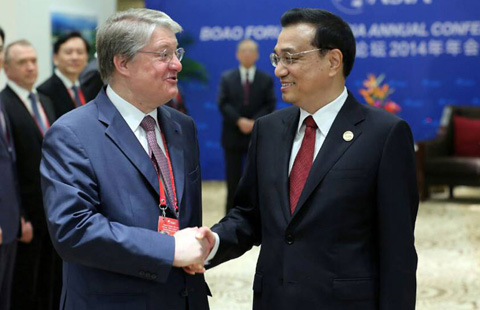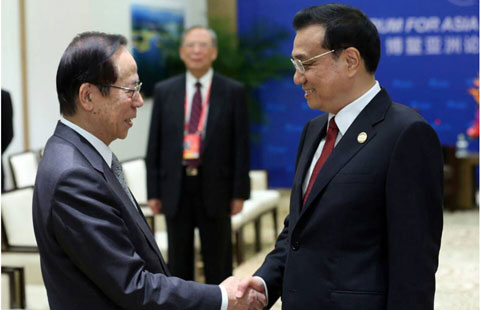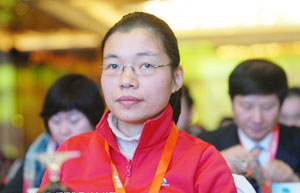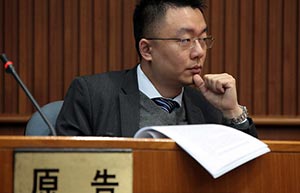Full text of Li Keqiang's speech at opening ceremony of Boao Forum
(Xinhua) Updated: 2014-04-11 02:22Third, we should maintain the general environment of peaceful development and build an Asian community of shared responsibilities. Regional turbulence courts disaster while stability in the neighborhood brings prosperity. Asia owes its progress to a peaceful and stable regional environment, and peace and stability are the fundamental safeguards for Asia's development. Sixty years ago, China, India and Myanmar jointly initiated the Five Principles of Peaceful Coexistence, which have become basic norms governing international relations. These principles embody Oriental wisdom and represent a major contribution to human civilization, and we should pass on the vision of peaceful coexistence from generation to generation. A close neighbor is better than a kinsman afar, and close neighbors can become best friends. To achieve peace and stability in Asia, we the Asian countries should build consensus, make active efforts and jointly fulfill our due responsibilities. We should promote security dialogue and consultation, strengthen cooperation on non-traditional security issues, including disaster management, maritime search and rescue, counter-terrorism and combating transnational crimes, and actively explore the establishment of a regional security cooperation framework in Asia.
Here I wish to emphasize that China is committed to peaceful development. We pursue a neighborhood policy of building amity and friendship, and we are firm in our resolve to uphold China's territorial sovereignty. We also follow a clear-cut policy of seeking peaceful solutions to disputes. We will give full support to initiatives that help strengthen maritime cooperation. We will not accept acts that undermine stability in the South China Sea. We Chinese believe in repaying kindness with kindness and meeting wrongdoing with justice. We value friendship and never treat friends unfairly, and we also stand by principles and firmly uphold our fundamental position. A peaceful and stable South China Sea is in the interest of all littoral countries, including China. China is ready to steadily advance consultation on a code of conduct in the South China Sea within the framework of the Declaration on the Conduct of Parties in the South China Sea, and work with other countries to ensure peace, stability and freedom of navigation in the South China Sea. China loves peace and cherishes development. It is ready to work with other countries in the region to build a peaceful, prosperous and open Asia and maintain peace, stability and tranquility in our neighborhood by enhancing political mutual trust.
Ladies and Gentlemen,
Asia's development is important to the future of the world, and China's development is closely bound up with Asia.
To keep China's economy running within a proper range is both a basic target of China's current macro-control and its medium-to-long-term policy goal. We have set this year's target of economic growth at about 7.5%. The word "about" indicates that there is a range for the GDP growth. As long as there is fairly sufficient employment and no major fluctuations, the actual GDP growth will be considered to be within the proper range, be it slightly higher or lower than the 7.5% target. Statistics show that urban employment continued to increase, individual income, corporate profits and fiscal revenue registered steady growth, consumer prices remained stable, growth of electricity consumption started to rise and there were positive dynamics in structural adjustment. In short, the Chinese economy has got off to a stable and good start. On the other hand, the upturn of the Chinese economy is not yet on a solid footing, downward pressure still exists, and difficulties in some fields must not be underestimated. These problems show the impact exerted on China by the complex international environment; they also reflect the prominent challenges and economic slowdown that China faces.
Preparedness ensures success. Faced with this complex situation, we need to calmly assess the current developments, stay focused, and take initiatives as called for. In exercising macro-control, we will endeavor to strike a balance between aggregate supply and demand, focus on improving the economic structure, ensure proper policy intensity of macro-control in the light of changing situation and take targeted and differentiated measures as appropriate. Last year, we pursued creative thinking and methods in exercising macro-control and gained new experience in this regard. We will not resort to short-term massive stimulus policies just because of temporary economic fluctuations and we will pay more attention to sound development in the medium to long run and strive for sustained and sound economic development. With all the principles established and policy options at our disposal, we can handle all possible risks and challenges. China's development has strong resilience. We have the capabilities and confidence to keep the economy functioning within the proper range.
There are conditions in place for the Chinese economy to achieve sustained sound growth. China has a big economy and large foreign exchange reserves. There is steady and coordinated progress in advancing the new type of industrialization, IT application, urbanization and agricultural modernization. And the Chinese market has broad space. There is much we can do to boost China's development. In particular, there is a large urban-rural gap in development. Population in the central, western and northeastern regions accounts for over 60% of the national total. And per capita GDP has just exceeded US$5,000. To narrow the gap between urban and rural areas and among different regions will unleash huge potential of growth. We have introduced a series of policies to advance reform, adjust structure and benefit the people, and more such measures are under consideration. All these will help ensure such steady growth.
Steady growth is possible only with a solid foundation just as long distance can be covered only by a vehicle with a high-powered engine. The Chinese economy has the basis for steady growth. It not only enjoys good conditions for maintaining medium to high speed growth in the time to come, but also inexhaustible impetus for sustained development. Under the theme of identifying new growth drivers, we will make multi-pronged efforts in the following three areas:
First, we will create impetus by deepening reform. The market has huge vitality and the people have indefinite creativity. We will work harder to streamline administration and delegate more power to lower level governments. We will introduce a system of listing government powers, consider the adoption of a management model based on a negative list approach, accumulate useful experience through the development of the China (Shanghai) Pilot Free Trade Zone and spread it to other areas. This will enable us to expand market access, foster a better business environment, encourage fair competition, develop a law-based economy, unleash greater dividends of reform, spark social creativity, and stabilize market expectations. Opening-up is also a kind of reform and can boost reform. We will carry out a new round of opening-up at a high level. An important part of this endeavor is to further open up the services sector, including the capital market. For example, we will actively create conditions to establish a Shanghai-Hong Kong stock exchanges connectivity mechanism, and further promote two-way opening-up and healthy development of the capital markets on the mainland and Hong Kong. We will continue to raise the level and quality of opening-up through deeper integration with the international market.
Second, we will create impetus by adjusting economic structure. We will narrow urban-rural and regional development gaps and address the unreasonable industrial structure to push forward structural adjustment through structural reform. We will speed up efforts to improve the services sector, which is our weak link, extend the pilot VAT reform to postal, telecommunications and other services sectors, use tax tools to develop producer and consumer services, and use more private capital to increase the supply of old-age support, health, tourism, cultural, sports and other services. We will implement a new type of people-centered urbanization, address the bifurcation between urban and rural areas and within cities, and grant urban residency in an orderly manner to rural people who have moved to cities. The government will increase support and use market tools to rebuild more rundown areas this year. We will expand development from the coastal areas to the inland regions in a phased way and nurture new economic support belts along the Yangtze River waterway and important land transportation trunks. We will push forward the construction of rail, road and other transport infrastructure in central and western regions to foster favorable conditions for industrial relocation. We will also promote the development of green industries, new energy, and energy-conserving and environment friendly technologies and products to foster new growth areas, and resolutely eliminate backward production facilities in this process to ease the resources and environmental constraints. We will increase the size of the national guidance fund for venture capital in emerging industries, leverage the role of innovation in spurring development, move industries up the value chain, and raise the productivity of factors of production.
- Deloitte positive on China's reform
- Regional integration key: King & Wood
- China has friendly approach: ECG director
- Pace important: Albright Stonebridge
- Bloomberg chief hails China reform
- Chinese pork firm launched $5.3b IPO in Hong Kong
- China to link exchanges of Shanghai, Hong Kong
- China stocks close higher on Thursday

















